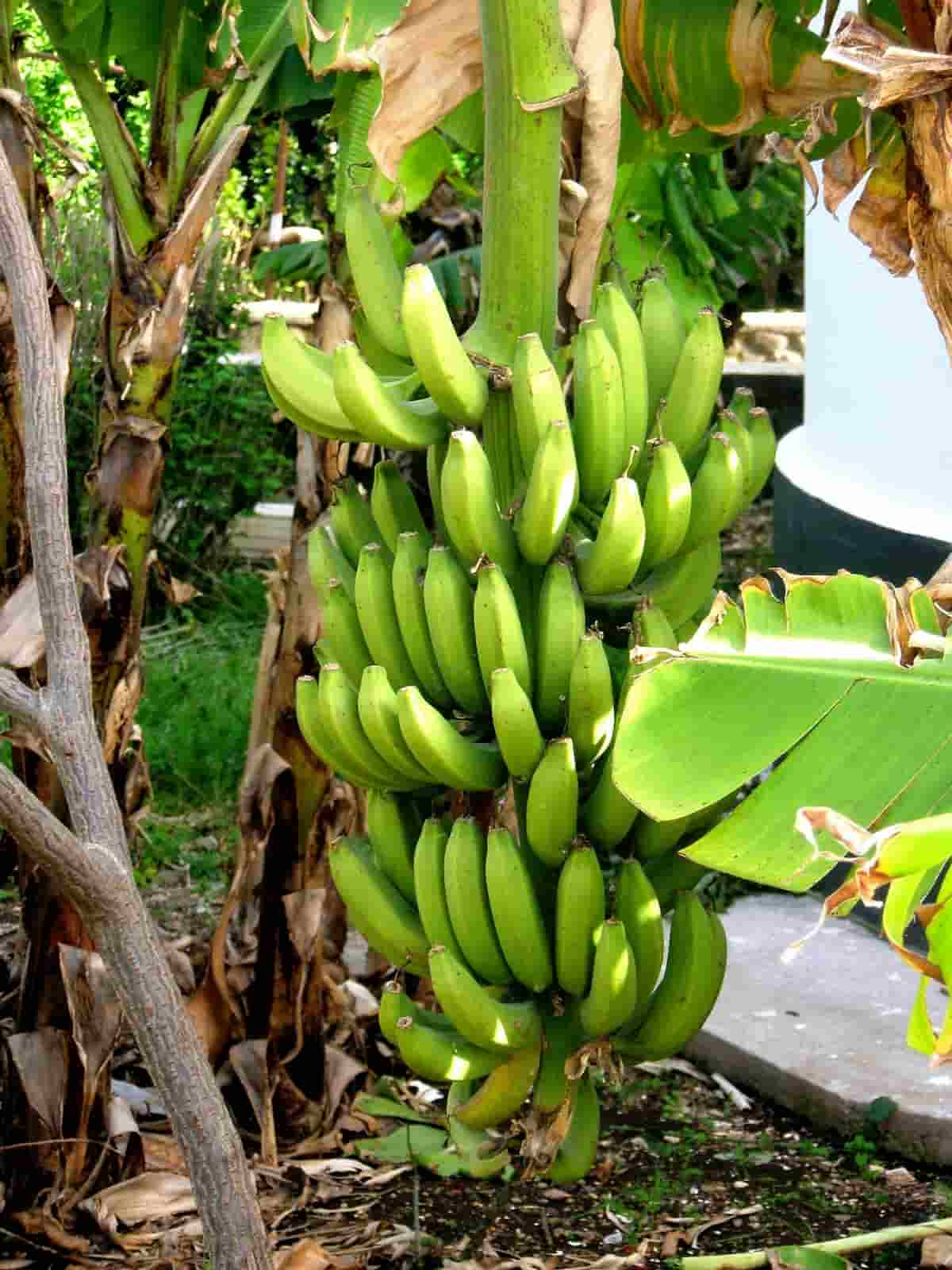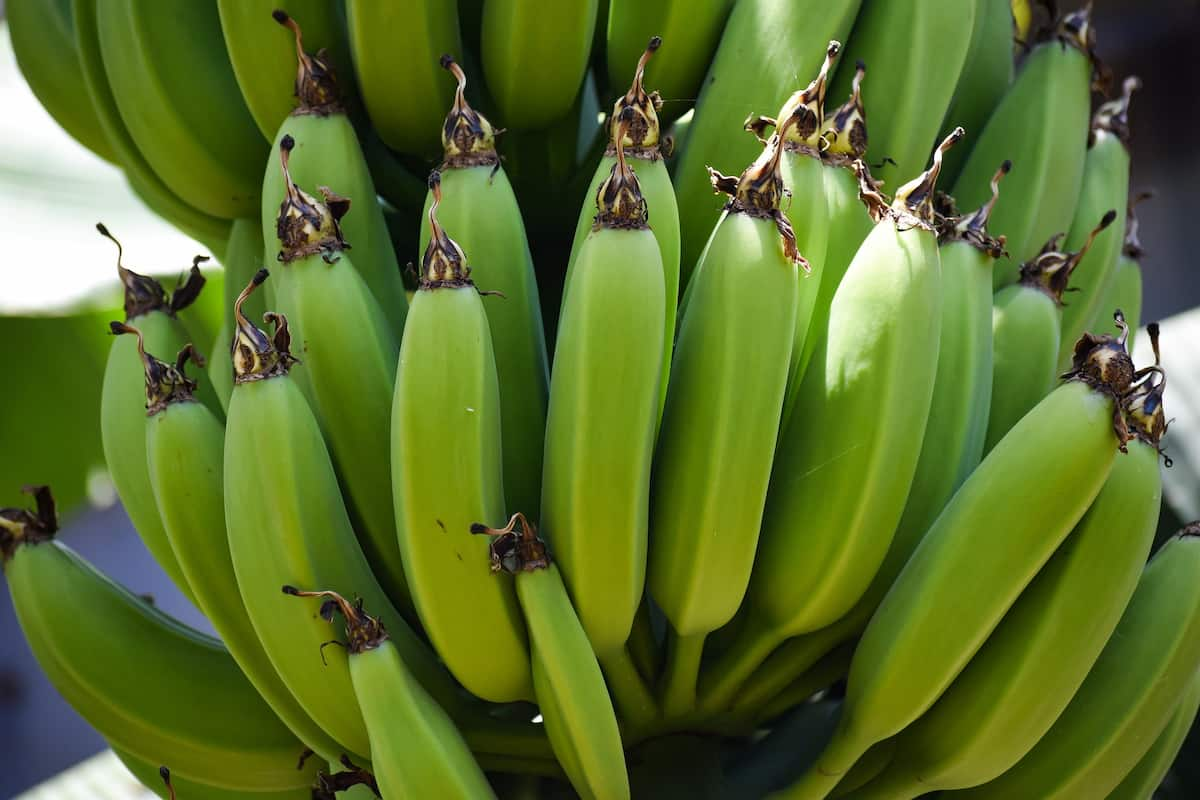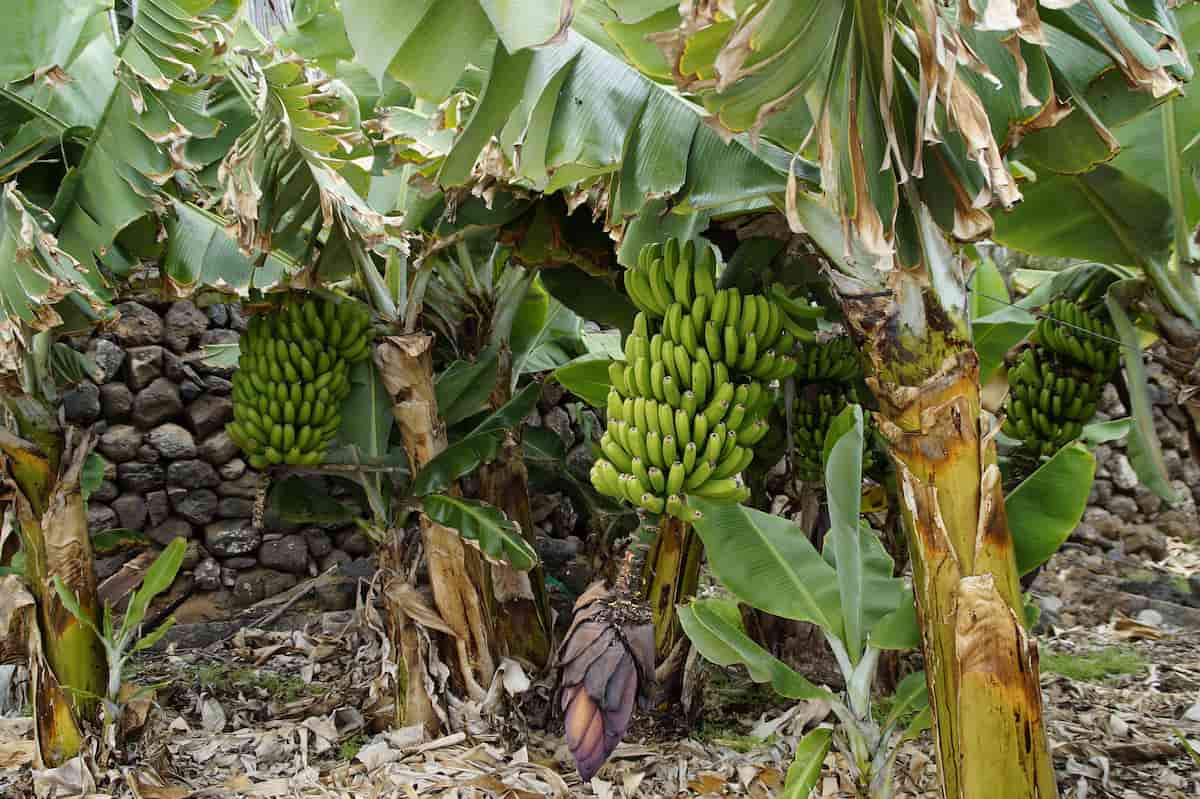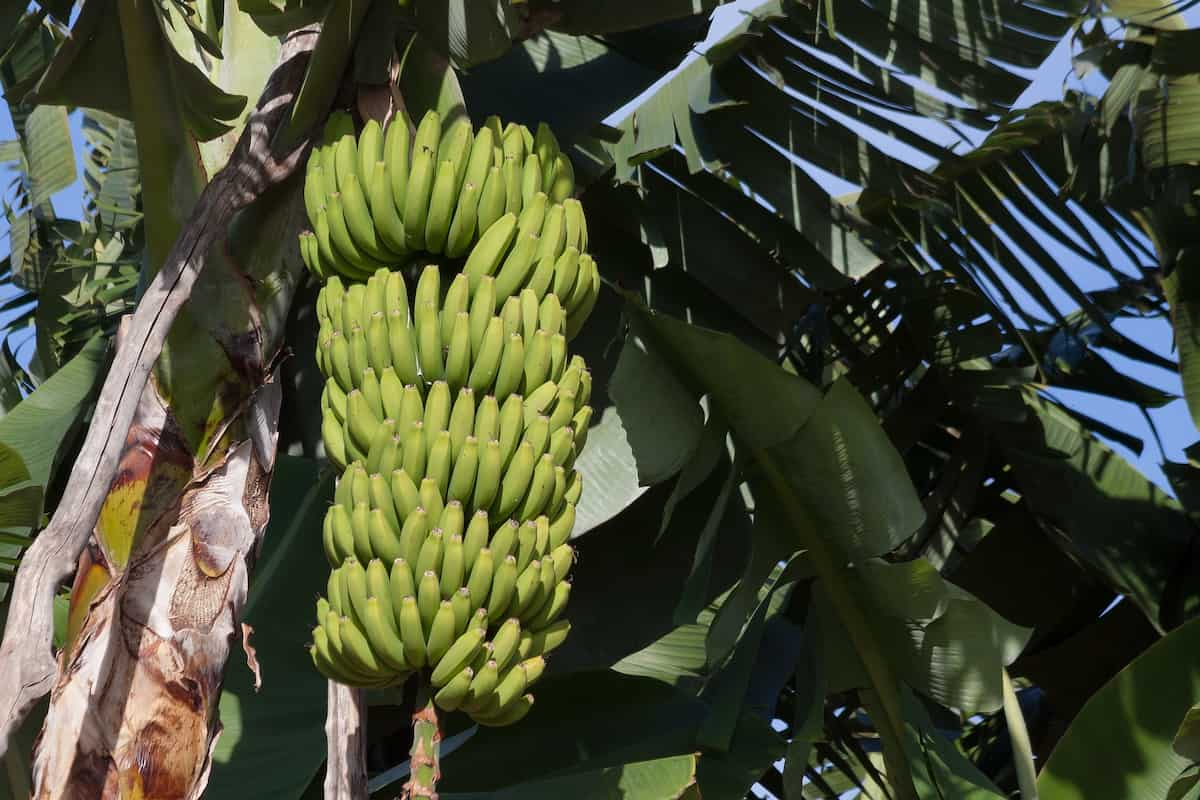Bananas are the oldest and most widely consumed fruits in the world. This plant belongs to the Musa genus (family Musaceae). There are two main uses for bananas: food and textile fiber. Among the most widely cultivated banana varieties in the world is Grand Naine Banana (G9). The tissue culture method is used all over India to produce large quantities of this variety of bananas.

Under sterile conditions, tissue culture involves cloning a single cell or plant material in a culture medium. Bananas are grown from corms, suckers, and sword suckers. Bananas of the G9 variety are the most commonly cultivated by farmers. In 1995, a high-yielding Cavendish variety was brought from Israel to India for commercial production. Approximately 17% of India’s total banana lands are planted with tissue culture plantlets of G9.
Grand Nain (G9) Banana farming in India
Characteristics of G9 Banana
- It is a solid green fruit with high export value and economically highly profitable
- The plant grows to a height of 6.5 to 7.5 Feet. The bunches can be harvested within eleven to twelve months of planting the tissue culture plants.
- G9 Banana roundness of the surface makes the fruit different from other varieties.
- The green color is in immature condition and yellowish in maturity. The length of the Banana is 9-10 inches.
- The fruits of the Grand Nain Banana variety are delicious to eat, and keeping quality of the fruit is high compared to our native varieties.
- Grand naine bananas or G9 bananas are taken as both fresh fruits and used in food processing industries.
- The total weight of the Banana is 40- 50 kg with drip irrigation has been recorded in many states.
- It provides large-scale production of disease-free fruits. However, they have a shorter harvesting period than the other native cultivars.
- The fruits are rich in fiber. One Banana can provide up to 10% of the daily requirement. In addition, it has ample vitamin B6 that helps against Type 2 diabetes and aids in weight loss.
Yield details of G9 Banana
- High-yielding Banana (Avg. 45 kg per plant).
- A.V.G weight of the single banana finger is 190-300 gms.
- Banana bunches can be harvested within eleven months from planting the G9 tissue culture plants in the main field.
- Each Grand nine Banana bunch will have 10 to 14 hands with 210 to 240 fruits.
In case you missed it: Honey Dew Papaya Farming in India: How to Start, Care, Pest, and Disease Management

G9 Banana planting season and cultivated states in India
Tissue-cultured plants are not season dependent. Therefore, they can be planted in the soil throughout the year. The Major difference between the normal and the tissue-cultured plants is that Tissue cultured plants will have twice the number of roots present in the normal plants.
This unique property gives the Plant strength and good nutrient-absorbing capacity, thus giving a good yield of an average of 30 – 55 kg/ bunch. Mainly in Uttar Pradesh, Tamil Nadu, West Bengal, Kerala, Maharashtra, Gujarat, Karnataka, Assam, Andhra Pradesh, Nagaland, Tripura, and Bihar.
Soil requirements for G9 Banana cultivation
Banana saplings can be planted on land with good drainage facilities. Banana plants will grow well in red and moderate soils with low sand content. Soil pH should be neutral or between 6 and 7.5. Poorly drained, poorly aerated, and nutritionally deficient soils are unsuitable for bananas. Banana cultivation is not possible in calcareous, saline soils.
Low-lying areas, very sandy soil and heavy black cotton with poor drainage should be avoided. Therefore, the soil is recommended to be tested in a suitable laboratory or government-based horticulture lab to confirm the soil’s pH. If the soil is more acidic, it is to be neutralized using gypsum and if the soil is more basic, neutralize it with Dolomite. It is important to neutralize the soil to make it suitable for cultivation.
Agro-climatic requirements for G9 Banana cultivation
As a tropical crop, bananas grow well at temperatures ranging from 15°C to 35°C and relative humidity levels between 75% and 85%. Plants are grown from sea level to 2000 m above mean sea level in humid tropical lowlands. By selecting appropriate varieties, this crop is grown in climates ranging from humid tropical to dry mild subtropical.
When the temperature drops below 12°C, chilling injury occurs. In addition, crops will be damaged by high winds exceeding 80 km per hour. Banana vegetation grows most vigorously during the four monsoon months (June to September), with an average rainfall of 650 to 750 mm. In higher altitudes, banana cultivation is limited to a few varieties, such as “Hill banana.”
Land Preparation for G9 Banana cultivation
Plant your bananas before planting green manuring crops such as daincha, cowpea, etc., and bury them in the soil. 2-4 times can be plowed and leveled on the land to prepare it. Make a slight tilt in the soil by plowing to break up the clods. The base dose of farm yard manure is added and thoroughly mixed into the soil during soil preparation. The pit should be 45cm by 45cm by 45cm in size. Topsoil will be refilled with 10 kg of farmyard manure (well decomposed), 250 gm of Neem cake, and 20 gm of Carbofuran.
By exposing prepared pits to solar radiation, harmful insects are killed, soil-borne diseases are prevented, and aeration is facilitated. In saline-alkali soils with a pH above 8, the organic matter must be incorporated into the pit mixture. Perlite improves porosity and aeration by improving porosity and reducing salinity. Planting in furrows is an alternative to planting in pits. A plant’s spacing and depth can be determined based on the soil strata and the method of planting.
Selection of G9 Banana planting material
As propagating material, sword suckers weighing approximately 1.5 to 2 kg are commonly used. Generally, suckers may be infected with nematodes and pathogens. In addition, the crop is not uniform due to the variation in age and size of the sucker, and harvesting takes longer, making management more difficult. For planting, in-vitro clonal propagation, i.e., tissue culture plants, is recommended. It is a healthy, disease-free, uniform, and authentic product. It is only recommended to plant hardened secondary seedlings.
In case you missed it: Totapuri Mango Farming in India: A Complete Cultivation Guide to Planting to Harvesting

Pre-treatment of suckers
Prune the roots and decayed portion of the corm, cutting the pseudostems, and grading the suckers. Carbofuran 3 G granules make praline with 40 g per sucker. For nematode control, dip the corm in a slurry solution containing four clay parts plus five water. You can dip the corms in 0.75% Monocrotophos, let them dry for at least 24 hours, then plant them.
Sunhemp is sown on the 45th day and incorporated after about a month. This operation reduces nematode buildup. Tissue-cultured banana plants with five to six leaves can be used. Apply 25 g of Pseudomonas fluorescence per plant when planting.
Planting method for G9 Banana cultivation
A polybag is separated from plants without disturbing the root ball, and then the plants are planted in pits with the pseudostem 2 cm below ground level. Around the plant, the soil is gently pressed. It is best to avoid deep planting. A 6 x 6 ft spacing is recommended for planting 1200 plants per acre. The spacing can also be 6 feet x 5 feet; however, many growers do so.
Water management in G9 Banana cultivation
For maximum productivity, banana plants require a lot of water. Banana roots, however, cannot draw water from the ground. Drip irrigation is an effective irrigation system for banana production under Indian conditions. Water requirements for bananas have been calculated at 2000 mm per year. It has been reported that drip irrigation and mulching improve water efficiency.
The drip system saves 56% of water and increases yield by 23 to 32%. Plants should be irrigated immediately after planting. Maintain field capacity by applying sufficient water. A lack of air in the soil pores will result in root zone congestion, affecting the establishment and growth of plants. Therefore, drip irrigation is essential for banana water management.
Fertilization requirements for G9 Banana cultivation
The banana plant requires a high level of nutrients, often only partially supplied by the soil. Nutrient requirements per plant are 10 kg farm yard manure, 200 – 250 grams of N, 60-70 grams of P, and 300 grams of K. Per metric ton yield, bananas require 7 to 8 kilograms of N, 1 to 1.5 kilograms of P, and 17 to 20 kilograms of K. Farmers traditionally use more urea and less phosphorous and potash. Three to four split doses of urea are applied.
Nitrogen
A top dressing of 100 grams of N/plant should be applied 60, 90, and 120 days after planting in three equal split doses. At planting, 100 grams of potash and 40 grams of phosphorus should also be applied. At planting, P and K should be applied in full doses and N in three equal doses in shallow rings about 8-10 cm deep.
Phosphorus
There is a relatively low requirement for phosphorus. During planting, superphosphate is the major P source, followed by rock phosphate at a rate of 50-95 grams per plant. The use of triple superphosphate or diammonium phosphate is recommended for acidic soils. During planting, phosphorus is applied in a single dose. Depending on the soil type, P2O5 amounts can vary from 20 to 40 grams per plant.
Potassium
In banana cultivation, potassium plays a vital role in vital functions. Temperature affects its availability, as it cannot be stored. At the finger-filling stage, continuous supply is required. The recommendation is to apply K (100 grams) in two splits during the vegetative phase and 100 grams in two splits during the reproductive phase. Depending on the cultivar, 200-300 grams of K2O should be applied.
Calcium
Calcium influences yield through its interactions with N, P, and K. Dolomite (Mg2CO3) and limestone (CaCO3) are commonly used as soil amendments in acidic soils.
In case you missed it: State Wise Tomato Farming Seasons in India: Growing Best Varieties and Production Yield

Intercrops
Onion, soybean, green gram, black gram, beans, radish, greens, marigolds, and cowpea can be grown as intercrop in a G9 Banana cultivating field. Planting an intercrop will give additional income. Growing intercrops like cowpea and soybean also help suppress weed growth. The income and expenditure for intercropping are not considered in preparation for the model scheme.
Mulching
Mulching is desirable immediately after planting. Mulching is useful in conserving soil moisture, and increasing the number of feeder roots, thereby improving the nutrient and water use efficiency suppression of weed growth and enhancing the banana yield by 30-40%. The main types of mulch used in banana plantations are plant residues from the banana crop or other crops and polyethylene mulch.
Major diseases in Banana
Erwinia rot
Symptoms
- This disease is more pronounced on young suckers leading to rotting and emitting of foul odor
- Rotting of the crown region is a characteristic symptom followed by epinasty of leaves, which dry out suddenly
- If affected plants are pulled out, it comes out from the crown region, leaving the corm with their roots in the soil
Management
- Good drainage and soil conditioning can control the disease to some extent.
- Plant disease-free suckers.
- Remove infected plants immediately.
- Remove plant residues after harvest.
- Dip suckers in copper oxychloride (40g/10l)+ streptocycline (3g/10lit) for 30 min before planting.o invade into the Plant
Leaf Spot, Leaf Streak, or Sigatoka Disease
Symptoms
- Initial symptoms appear in the form of light yellowish spots on the leaves.
- A few of these enlarge and become oval; the color also changes to dark brown.
- Still later, the center of the spot dies, turning light grey and surrounded by a brown ring.
- In severe cases, numerous spots coalesce, killing large parts of the leaf. Rainfall, dew, and temperature determine the spread of the disease.
Control
- It is recommended to improve drainage, control weeds, remove disease suckers, and adopt correct spacing practices.
- The disease can be controlled with Dithane M-45 WP (in the oil-water emulsion) and Dithane M-45 (in water only).
- Foliar sprays of Copper Oxychloride (3 g/litre of water) or Thiophanate Methyl (1 g/litre of water) control the disease well.
Mosaic Virus
- Typical mosaic symptoms on the leaves characterize the disease. Mosaic plants are easily recognized by their dwarf growth and mottled, distorted leaves.
- The earliest symptoms appear on young leaves as light green or yellowish streaks and bands, giving a mottled appearance.
Control and management
- Plantations should not allow weeds to grow. It is not recommended to plant suckers from infected clumps.
- Removing weeds in the nearby area during the offseason is important since the virus survives there. Insecticides can also be used to prevent the spread of the disease.
In case you missed it: How to Start Alphonso Mango Farming in India: A Cultivation Guide to Planting to Harvesting

Major pests in G9 Banana
Pseudostem Borer
Damage symptoms
- There are two types of adults: reddish brown and black. During the summer and monsoon months, the pest is active.
- Grubs bore into the main stem and feed within them.
- The grub bores a hole in the plant and exudes sap and blackened masses as its initial symptom. Finally, the plant dies as a whole.
Control methods
- Insect eggs, larvae, pupae, and adults can be controlled with aluminum phosphide (3 tablets/plant).
- The application of Carbofuran (3 g of granules/stool) is very effective in controlling the pest.
- Alternately, the application of Endosulphan (0.04%) or Carbaryl W.P. (0.1%) also controls the pest population.
Banana Aphid
- Insects transmit the virus that causes bunchy top disease. In addition to sucking cell sap from plants, yellowish-green nymphs and adults devitalize them.
- The affected parts become discolored and malformed. The rapid multiplication of this pest is favored by high humidity.
- In most cases, aphids are found on the lower surface of the leaves.
Control methods
- Aphid populations are effectively controlled by spraying Monocrotophos (0.05%) or Malathion (0.1%) at 10-15 day intervals.
- Phorate, a granular insecticide, should be applied to the soil at 1.0 kg a.i./ha to prevent the pest from returning.
Fruit and Leaf Scarring Beetle
- During the rainy season, this pest is most prevalent. The beetle feeds on young leaves and fruit skins during the adult stage.
- Infested fruits become spotted, and severe scarring of the fruit skin reduces its commercial value.
Control methods
- Plantations with high grass weed populations can often be controlled without using insecticides by removing grass weeds. As a result, insecticides should be avoided unless the beetles are causing serious economic damage.
- In severe infestations, spraying with Endosulphan (0.04%) or Carbaryl W.P. (0.1 %) controls the pest population.
Burrowing Nematode
Damage symptoms
- A small dark spot appears on the root as the first symptom.
- In the root tissue, the nematode deposits eggs. Larvae consume root tissue. When root tissue is damaged, fungi quickly invade it.
- Individual fruits are smaller, and there are fewer fruits in the bunch.
Control methods
- Applying Carbofuran 3G or Phorate 10G at ten g/pitorg neem cake (250-400 g/pit) at the planting time reduces the pest population.
- In addition, control measures such as applying nematicides to the growing infected G9
In case you missed it: Shimla Apple Farming in India: Cultivation Practices, Planting to Harvesting, and Production

Harvesting G9 Banana crop
G9 bananas are harvested when they are slightly or fully mature, depending on the market’s preferences. Harvesting is done at 75-80 % maturity for long-distance transportation. Fruits are climacteric and can be consumed after ripening. Planting a banana crop takes 12-15 months, and the main harvesting season is September through April.
Depending on the variety, soil, weather, and elevation, bundles mature between 90 and 150 days after flowering. With a sharp sickle 30cm above the first hand, harvest the bunch when the fingers of the second hand from the top are 3/4 rounded. The first hand may not be harvested for up to 100-110 days after the first hand is opened.
Harvested bunches should be placed in a well-padded tray or basket and brought to the collection site. After harvest, keep the bundles out of light to prevent ripening and softening. Retailers often sell hands-on stalks for local consumption. For the development of ratoon crops, only leaves are cut after harvesting the bunch. Approximately 15% of irrigation costs can be saved as a result.
Conclusion
The Grand Naine banana is becoming more popular due to its tolerance to biotic stresses and high-quality bunches. Though, bunches have well-spaced hands with straight orientations of figures, larger. This cultivar develops a uniform yellow color and has a better shelf life and quality than other cultivars.
- Types of Pesticides Used in Agriculture: A Beginner’s Guide
- Economical Aquaculture: A Guide to Low-Budget Fish Farming
- 15 Common Planting Errors That Can Doom Your Fruit Trees
- How to Make Houseplants Bushy: Effective Tips and Ideas
- Innovative Strategies for Boosting Coconut Pollination and Yield
- Pollination Strategies for Maximum Pumpkin Yield
- The Complete Guide to Chicken Fattening: Strategies for Maximum Growth
- Natural Solutions for Tulip Problems: 100% Effective Remedies for Leaf and Bulb-Related Issues
- Revolutionizing Citrus Preservation: Towards a Healthier, Greener Future
- Natural Solutions for Peony Leaf and Flower Problems: 100% Effective Remedies
- Maximizing Profits with Avocado Contract Farming in India: A Comprehensive Guide
- Natural Solutions for Hydrangea Problems: 100% Effective Remedies for Leaf and Flowers
- The Ultimate Guide to Choosing the Perfect Foliage Friend: Bringing Life Indoors
- From Sunlight to Sustainability: 15 Ways to Use Solar Technology in Agriculture
- The Ultimate Guide to Dong Tao Chicken: Exploring from History to Raising
- The Eco-Friendly Makeover: How to Convert Your Unused Swimming Pool into a Fish Pond
- Mastering the Art of Delaware Chicken Farming: Essentials for Healthy Backyard Flocks
- 20 Best Homemade Fertilizers for Money Plant: DIY Recipes and Application Methods
- How to Craft a Comprehensive Free-Range Chicken Farming Business Plan
- Brighten Your Flock: Raising Easter Egger Chickens for Beauty and Bounty
- How to Optimize Your Poultry Egg Farm Business Plan with These Strategies
- Subsidy for Spirulina Cultivation: How Indian Government Schemes Encouraging Spirulina Farmers
- Ultimate Guide to Raising Dominique Chickens: Breeding, Feeding, Egg-Production, and Care
- Mastering the Art of Raising Jersey Giant Chickens: Care, Feeding, and More
- Ultimate Guide to Raising Legbar Chickens: Breeding, Farming Practices, Diet, Egg-Production
- How to Raise Welsummer Chickens: A Comprehensive Guide for Beginners
- How to Protect Indoor Plants in Winter: A Comprehensive Guide
- Ultimate Guide to Grow Bag Gardening: Tips, Tricks, and Planting Ideas for Urban Gardeners
- Guide to Lotus Cultivation: How to Propagate, Plant, Grow, Care, Cost, and Profit
- Agriculture Drone Subsidy Scheme: Government Kisan Subsidy, License, and How to Apply Online
- Ultimate Guide to Raising Araucana Chickens: Breed Profile, Farming Economics, Diet, and Care
- Bringing Hydroponics to Classroom: Importance, Benefits of Learning for School Students
- Ultimate Guide to Raising Polish Chickens: Breed Profile, Farming Economics, Diet, and Care
- Ultimate Guide to Raising Australorp Chickens: Profile, Farming Economics, Egg Production, Diet, and Care
- Silkie Chicken Farming: Raising Practices, Varieties, Egg Production, Diet, and Care
- Sussex Chicken Farming: Raising Practices, Varieties, Egg Production, Diet and Care